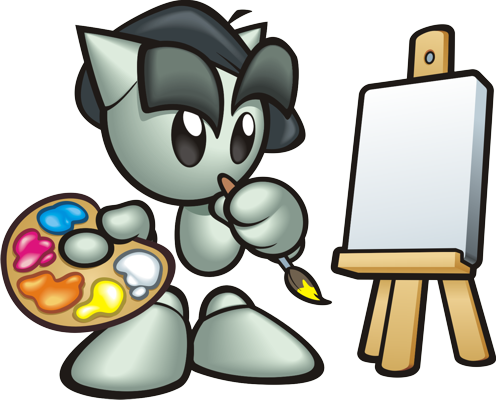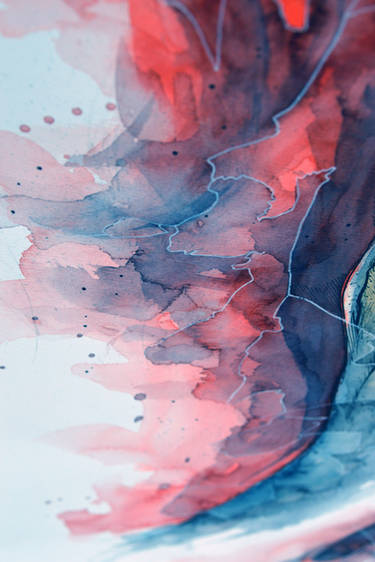
✿ Watercolor Equipment
Watercolor is a painting technique in which the paints are made of pigments suspended in a water-soluble binder. Usually, the result is transparent and appear luminous because the pigments are laid down in a relatively pure form with a few fillers obscuring the pigment color. This medium was never taken as seriously as "high art" techniques such as oil painting and was rather seen as pale and miniaturist, but it's gradually reclaiming it's place as a vehicle for the most beautiful and unexpected artistic expression. Watercolor can be vibrant and large, very vital, spontaneous and leaning a little on luck. All these aspects make watercolor painting a medium with great potential for new discoveries.
PaperBrushesPaints
In general, a few recommendations apply to all material categories:
✿ Watercolor painting technique is hard to learn, but insanely difficult without proper tools. Use high quality equipment from the beginning to be achieve best results and progress.
✿ Even though high quality means more expensive, carefully plan what to buy. In many cases, high price does not equal high quality.
✿ Please, before you put your shoes on and run to a big store, study about art supplies online. Search for an accurate information, even if it's hard to keep the distance from commercial hype.
✿ Finally, test your own supplies and find out what best suits your needs. Keep in mind that products can change in time, companies sometimes modify their manufacturing methods due to business decisions.
✐ 1. Paper
Papers are mouldmade (majority) or handmade. They come in three surface finishes - rough (R), cold-pressed (NOT or NP) and hot-pressed (HOT or HP). Regarding weight, papers available are made within the range of 200 gms (90 lb) to 620 gms (300 lb) - a paper's surface finish varies by weight, heavier sheets by the same manufacturer typically have a coarser texture in the same normal finish. Lastly, consider the paper color, the range of whites varies greatly but variety of cool and warm tints is available. Also, in most papers the rough finish has a slightly darker tone than NP and hot-pressed slightly lighter. This is an important factor to consider, given that paper is the source of light for your watercolor painting.
✿ How papers are made
Paper manufacturers use the fibrous plant material cellulose, which plants use to build the cell walls in stems and leaves. For European and American papers, cellulose is extracted from cotton, flax (linen) or wood pulp, for traditional Asian papers from jute, kozo, salago or mitsumata. A sheet of paper is basically a thin mat of tangled cellulose fibers. The grade or quality of cellulose is determined by how much of the plant material dissolves in different chemical solutions. Based on this characteristic we know alpha (portion of plant material that does not dissolve in a moderate solution of sodium hydroxide at room temperature) and beta (the dissolved portion that precipitate when an acid is added to the solution) cellulose. Alpha cellulose is the most stable and permanent part of extracted plant material.
Cotton cellulose fibers are called cotton rag, these fibers are flexible and strong, and because they are naturally long, they produce papers that resist tearing. They are almost 100% alpha cellulose, naturally white and already separated, which means little or no bleaching or chemical treatments are necessary. Linen cellulose fibers (from flax) are longer and stronger than cotton, which makes linen papers harder and more translucent. By far the most common source of cellulose in machine-made papers is wood pulp. Cellulose is extracted from wood pulp using either mechanical or chemical methods, resulting in a coarse, brownish paper commonly used in wrapping papers, packaging, newsprint and paperboard. Mechanical methods can leave a considerable residue of lignin, a kind of glue that binds together the cellulose fibers of a living plant. Lignin repels water, causes clumping in the paper pulp during manufacture and becomes acidic and turns a yellow or brown color with age, so it is necessary to remove it completely in quality paper production (look for acid-free papers).
CONCLUSION & RECOMMENDATION: Cotton cellulose is up to 10 times stronger than wood cellulose and naturally lignin free and acid free. Some residual lignin and chemicals remain in chemically extracted wood cellulose, which cause embrittlement and acidification over time. For this reason, wood pulp papers should generally be avoided for archival or museum quality artwork. Papers made from 100% cotton, 100% linen or pure cotton/linen rag are all suitable for artistic use.
Many painters are not aware that quality papers are more durable than fabric or wood supports. Recent improvements in lightfastness of watercolor pigments mean that today's watercolor paintings can last unchanged for centuries - the standard is archival quality paper with an acid-free or pH neutral furnish.
✿ Brands & Resources
ARCHES ✿ CANSON ✿ FABRIANO ✿ HAHNEMUHLE ✿ SENNELIER ✿ WINSOR & NEWTON ✿ LANGTON
Watercolor paper guide ✿ Watercolor papers review ✿ Paper Stretching
✐ 2. Brushes
Your choice of brush always depends on your painting technique and working practices. The brand of brush you use is not as important as using a brush you enjoy and trust. Buy sparingly and with reason - few brushes can satisfy all your painting needs. Some of the most important criteria to consider is durability (responsiveness over time) which becomes apparent only after a long use, brush quality - therefore the quality of the tuft material, how they are shaped and secured to the handle which defines how much water it can hold and how long it stands up to use. Beware of some marketing designations that are often misleading such as the word "kolinsky" (I will explain further).
✿ Brush Labeling
In a brushmaker's world, the label "kolinsky" refers to the guard hairs from the tail of the winter pelt of a male animal. These hair are a distinctive orangish brown with a dark tip. The animal (Mustela sibirica or Siberian weasel) must live in very cold climates for the hair to achieve the desired thickness and length. As kolinskies do not breed in captivity, the reclusive animals must be caught in the wild by vodka fortified trappers. Some "kolinsky" brushes are made of very different Mustela species, often cultivated in warmer (commercially more convenient) climates, which affects the hair quality. Less desirable grades of hair also called "kolinsky" come from other parts of the pelt, from the pelts of female animals or from summer coats - this hair is sometimes very different from the male winter pelt. As you can see, the word "kolinsky" does not consistently refer to any species of harvested animal, type of hair or hair attributes.
Watercolor brushes come in confusingly wide range of sizes, types and materials. Two most commonly used types (shapes) are round brushes and flat brushes. A high quality round renders a wide range of shapes and effects, holds a good charge of water, wicks up excess paint and rinses out quickly. The extraordinary flexibility of this brush means it is the instrument of choice for "gestural" painters who want a lot of expressiveness in the brush marks. Flat, on the other hand, are chisel shaped brushes with a straight edge. Flats are ideal for laying down large areas of even color or pure water, for shaping precise color edges, building graded washes.
Natural hair is in many respects the superior material to use in a brush. Besides already mentioned kolinsky sables, commonly used hair for brush making include red sable (Martes species, thinner and stiffer than kolinsky), squirrel hair (exceptionally soft, absorbent hair), ox hair (brown or reddish hair taken from the ears of cattle, it's inexpensive and strong, which makes them great for rougher brush techniques), boar bristle (pale or white bristle, very stiff, more suitable for oil or acrylic but watercolorists sometimes use them to add textures to their work), mongoose hair (very distinctive coloring, stiff, holds a lot of liquid - again very suitable for texturing or creating effects), goat hair and camel.
Besides sable brushes, the variety of synthetic fibers on the market is available. The best synthetics are as resilient as sable, as thirsty as squirrel, but they soften and wear quickly in use. Synthetic fibers are made of nylon, polyester or other filaments. Color is not a factor in judging their quality. Synthetics don't usually point well when used alone in a brush, so they are often mixed with natural hair. Many lines of brushes today mix bristle types - these are often bargain and produce perfectly satisfactory results.
✿ Brands & Resources
✐ 3. Paints
In the past, artists used to make their own materials. Nowadays, painters rely on commercial brand reputation, recommendations from other artists/art books or simply stick to what they know. Good advice does not always last, don't be surprised if you realize one day that the product you always used is somehow different (manufacturers can change their products or simply stop making a specific pigment).
Commercial watercolor paints can be purchased in two most common forms - pans (dry cake in small plastic cans) and tubes (a thick liquid or paste packaged in metal cubes). There's much more to the forms of packaging than difference in price. Dry pan colors are quick to set up and paint with, also very easy to clean up. If well protected, they will store indefinitely. There is no wasted color, they are compact and easy to transport, but also harder to make mixes with and relatively expensive for the amount of pigment they contain. Tubes, on the other hand, are efficient for mixing up large quantities of paint. They are ready for mixing straight from the tube and dissolve quickly in water. However, it's hard to judge just how much paint you need for your next painting, and whatever amount you don't use ends up wasted (re-wetting a dry tube paint on your palette is not recommended). Also, once a tube paint gets contaminated with other colors, it's hard to retrieve. Finally, metal tubes are not ideal packaging solution due to numerous reasons (pigment and its vehicle separate when paint isn't used for some time, the cap sticks if it's gummed up with paint, paint can dry out). Some artists claim that using tube watercolor paints leads to more vibrant results but the difference may simply be due to the fact that it's easier to achieve a high concentration of paint and water (some use paint straight from the tube) - the pigments are identical in either form. Another ugly myth is that pans are for children and students while tubes for "real" artists, in history many exceptional painters preferred pans even in a studio.
With all that being said, I still suggest - if you are an occasional painter - to get pans over tubes, due to practical reasons.
The newest packaging idea are liquid watercolors - pigment and vehicle prediluted in distilled water. This is a category with significant differences among products. The most popular brand is Dr. Ph. Martin's. These radiant watercolors are not true watercolors (pigment suspensions) but moderately diluted, synchromatic transparent aniline dyes. Many of these colors are exceptionally brilliant but equally fugitive - they stain the paper immediately and cannot be revised. These colors are efficient enough to use in graphical art applications intended for photographic reproduction or printing, but otherwise they are not suitable to be used in an artwork you expect to last for more than a few months.
✿ Other attributes of watercolor paints
✿ Watercolor pigments > are either natural (found in earth, mineral, clay etc.) or synthetic. Here is a great resource to learn everything about the material attributes of paint. When choosing pigments for your palette, use GUIDE TO WATERCOLOR PIGMENTS.
✿ Lightfastness > this factor indicates whether the color you see in a painting today will last. Once you've chosen and purchased paints, it is recommended to do your own lightfastness test.
✿ Transparency > transparent watercolor allows the light to shine through the watercolor paper and in turn lets the white of the paper reflect back. The colors look clean, crisp and appear to glow. Opaque colors, on the other hand, block the light from coming through to the watercolor paper. Instead, the light bounces off the pigment. This can make the colors appear to look dull, even though some of the opaque's are quite vibrant in color. Information about whether the color you've chosen in transparent, semi-opaque or opaque is usually provided in a catalogue.
✿ Staining > Non-staining watercolor pigments will settle on the paper surface once the water has evaporated. These colors allow you to lift the pigment off the surface and reveal the white of the paper underneath. Staining color, in contrast, immediately absorb into the first few layers of watercolor paper and will leave a stained tint of the color. Again, use the recommended GUIDE TO WATERCOLOR PIGMENTS to see which pigments stain strongly and which don't (pigments stain simply due to a very small particle size). Beginners will be better off using non-staining pigments.
✿ "Artist" versus "Student" paints > Some manufacturers offer two lines of watercolor products - artist (finest) quality and a student line that is typically less expensive and comes in a smaller color selection and tube sizes. The cost difference is usually achieved by using less or a lower grade of pigment and the addition of brighteners and fillers. Since price is a poor judge of quality of a product, "professional" paints made by some manufacturers can be of lower quality than student line of the most reputable brands. It is highly recommended to buy the highest quality product and focus on value for your money (tinting strength, lightfastness, packaging quality and color appearance).
✿ Brands & Resources
Watercolor paint buying guide ✿ Choosing watercolors ✿ Properties of Watercolor painting



